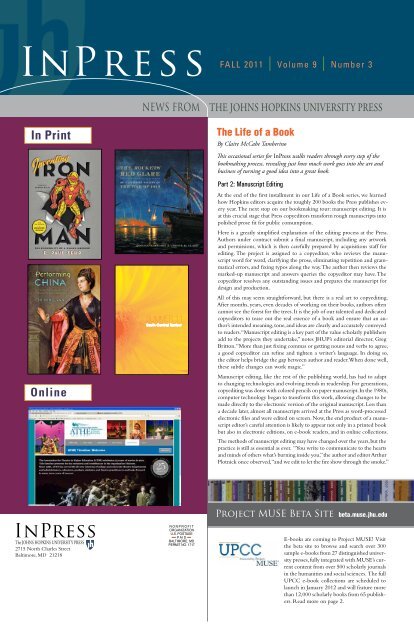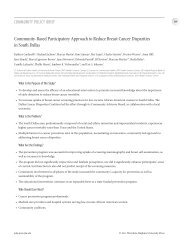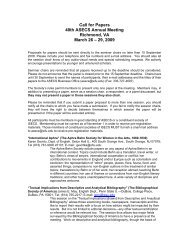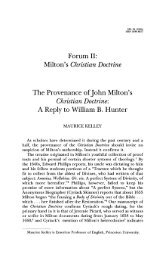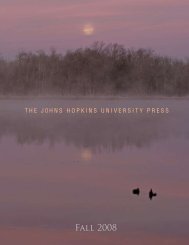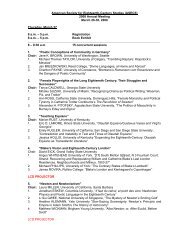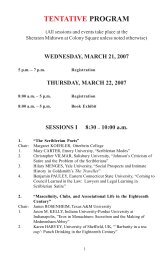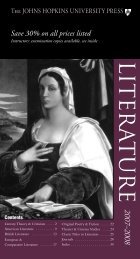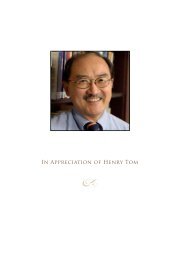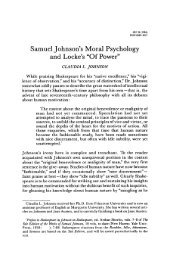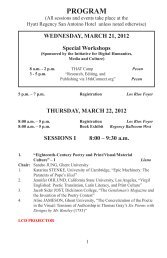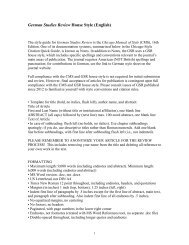Fall 2011 - The Johns Hopkins University Press
Fall 2011 - The Johns Hopkins University Press
Fall 2011 - The Johns Hopkins University Press
You also want an ePaper? Increase the reach of your titles
YUMPU automatically turns print PDFs into web optimized ePapers that Google loves.
In<strong>Press</strong><br />
FALL<br />
<strong>2011</strong> Volume 9 Number 3<br />
In Print<br />
News From<br />
<strong>The</strong> JOHNS HOPKINS UNIVERSITY PRESS<br />
<strong>The</strong> Life of a Book<br />
By Claire McCabe Tamberino<br />
This occasional series for In<strong>Press</strong> walks readers through every step of the<br />
bookmaking process, revealing just how much work goes into the art and<br />
business of turning a good idea into a great book.<br />
Part 2: Manuscript Editing<br />
At the end of the first installment in our Life of a Book series, we learned<br />
how <strong>Hopkins</strong> editors acquire the roughly 200 books the <strong>Press</strong> publishes every<br />
year. <strong>The</strong> next stop on our bookmaking tour: manuscript editing. It is<br />
at this crucial stage that <strong>Press</strong> copyeditors transform rough manuscripts into<br />
polished prose fit for public consumption.<br />
South Central modern language aSSoCiation<br />
PubliShed by the JohnS hoPkinS univerSity PreSS<br />
Online<br />
South Central review vol. 28, no. 2, Summer <strong>2011</strong><br />
Summer 11<br />
South Central Review<br />
Here is a greatly simplified explanation of the editing process at the <strong>Press</strong>.<br />
Authors under contract submit a final manuscript, including any artwork<br />
and permissions, which is then carefully prepared by acquisitions staff for<br />
editing. <strong>The</strong> project is assigned to a copyeditor, who reviews the manuscript<br />
word for word, clarifying the prose, eliminating repetition and grammatical<br />
errors, and fixing typos along the way. <strong>The</strong> author then reviews the<br />
marked-up manuscript and answers queries the copyeditor may have. <strong>The</strong><br />
copyeditor resolves any outstanding issues and prepares the manuscript for<br />
design and production.<br />
All of this may seem straightforward, but there is a real art to copyediting.<br />
After months, years, even decades of working on their books, authors often<br />
cannot see the forest for the trees. It is the job of our talented and dedicated<br />
copyeditors to tease out the real essence of a book and ensure that an author’s<br />
intended meaning, tone, and ideas are clearly and accurately conveyed<br />
to readers. “Manuscript editing is a key part of the value scholarly publishers<br />
add to the projects they undertake,” notes JHUP’s editorial director, Greg<br />
Britton. “More than just fixing commas or getting nouns and verbs to agree,<br />
a good copyeditor can refine and tighten a writer’s language. In doing so,<br />
the editor helps bridge the gap between author and reader. When done well,<br />
these subtle changes can work magic.”<br />
Manuscript editing, like the rest of the publishing world, has had to adapt<br />
to changing technologies and evolving trends in readership. For generations,<br />
copyediting was done with colored pencils on paper manuscript. In the 1980s,<br />
computer technology began to transform this work, allowing changes to be<br />
made directly to the electronic version of the original manuscript. Less than<br />
a decade later, almost all manuscripts arrived at the <strong>Press</strong> as word-processed<br />
electronic files and were edited on screen. Now, the end product of a manuscript<br />
editor’s careful attention is likely to appear not only in a printed book<br />
but also in electronic editions, on e-book readers, and in online collections.<br />
<strong>The</strong> methods of manuscript editing may have changed over the years, but the<br />
practice is still as essential as ever. “You write to communicate to the hearts<br />
and minds of others what’s burning inside you,” the author and editor Arthur<br />
Plotnick once observed, “and we edit to let the fire show through the smoke.”<br />
Project MUSE Beta Site beta.muse.jhu.edu<br />
In<strong>Press</strong><br />
<strong>The</strong> <strong>Johns</strong> <strong>Hopkins</strong> <strong>University</strong> <strong>Press</strong><br />
2715 North Charles Street<br />
Baltimore, MD 21218<br />
Nonprofit<br />
Organization<br />
U.S. Postage<br />
PAID<br />
Baltimore, MD<br />
Permit NO. 1717<br />
E-books are coming to Project MUSE! Visit<br />
the beta site to browse and search over 300<br />
sample e-books from 27 distinguished university<br />
presses, fully integrated with MUSE’s current<br />
content from over 500 scholarly journals<br />
in the humanities and social sciences. <strong>The</strong> full<br />
UPCC e-book collections are scheduled to<br />
launch in January 2012 and will feature more<br />
than 12,000 scholarly books from 65 publishers.<br />
Read more on page 2.
Text Message<br />
In the News Reviews Links Info<br />
Commentary from JHU <strong>Press</strong> Director Kathleen Keane<br />
During the summer I had the privilege to attend two interesting conferences<br />
that focused on the written word. Each brought together literary scholars and<br />
publishers, but each prompted a very different conversation about texts, how<br />
they will be published, and how they might be used.<br />
In early June, the JHU <strong>Press</strong> hosted the Eliot Prose Summit, a working meeting<br />
to review the status of our landmark project <strong>The</strong> Complete Prose Works of<br />
T. S. Eliot, which the <strong>Press</strong> will co-publish with Faber and Faber. <strong>The</strong> project<br />
involves seven of the world’s leading Eliot scholars, under the general editorship<br />
of Ronald Schuchard, working to identify and annotate all of Eliot’s prose<br />
in a definitive critical edition to be published online. This massive undertaking<br />
has much in common with the great works of scholarship our <strong>Press</strong> has published<br />
over many generations. Yet the volume editors have the added burden<br />
of anticipating how their work might be used in our digital age. How should<br />
this traditional sort of work appear online? How will the content be searched?<br />
What sorts of features and functionality should it offer?<br />
More recently, I attended the Scholarly Communications Institute sponsored<br />
by the Mellon Foundation and hosted by the <strong>University</strong> of Virginia Library.<br />
<strong>The</strong> new world we inhabit was even more apparent. At this conference, scholars,<br />
librarians, and technology specialists shared insights about numerous “digital<br />
humanities” projects that use powerful new technologies to archive, analyze,<br />
and “data mine” literary works. <strong>The</strong> results are machine-driven, offering surprising<br />
new ways to read and understand traditional texts.<br />
Both conferences reinforced the notion that digital publishing takes imagination,<br />
forethought, and a lot of careful planning, as we navigate technical processes<br />
such as file encoding and designing user interfaces. But both also showed<br />
that scholarly material—the text—remains at the heart of all our endeavors.<br />
Whether we open a printed book or a database, we do so because we are inspired<br />
by a particular work or driven to understand it better. While technology<br />
may be changing the ways scholarly publishers fulfill their mission, it doesn’t<br />
change the mission itself: to share knowledge and to meet the demands of the<br />
inquisitive mind.<br />
think<br />
we’ve been extremely fortunate<br />
in the first two years<br />
to have gotten so<br />
many distinguished<br />
writers to appear in<br />
the magazine. One<br />
of the things that <strong>The</strong><br />
<strong>Hopkins</strong><br />
In Conversation<br />
With Mark Denny<br />
Author of several books published (and copyedited)<br />
by the JHU <strong>Press</strong>, including, most recently,<br />
Gliding for Gold: <strong>The</strong> Physics of Winter Sports.<br />
How do you see the role of a copyeditor in a book project?<br />
Copyeditors ensure a more polished and finished book, and<br />
give the author confidence. For authors of nonfiction, it’s especially<br />
important to get the facts checked, and copyeditors are a great help here.<br />
Fortunately, I have not made any huge blunders, so far as I am aware, but many<br />
minor mistakes have been fixed by good copyediting.<br />
How important is it for authors to set aside their ego in the editing process?<br />
Crucial. I remember being so offended by the many cuts and alterations made by<br />
the JHUP copyeditor of my first book that I referred to her as “<strong>The</strong> Butcher of<br />
Baltimore.” <strong>The</strong>re is no doubt, however, that the book was improved as a result.<br />
What have you learned from working with copyeditors?<br />
<strong>The</strong> short answer is: how to write. I still e-mail Carolyn Moser, who has<br />
copyedited five of my books, with questions about grammar, or American colloquialisms,<br />
or any number of details concerning putting together a manuscript.<br />
She even advises me about preferred font types and layout for graphs and charts.<br />
Although the author’s name ends up on the cover, it really is a team effort, isn’t it?<br />
It is, and I always make sure that the copyeditor is duly acknowledged. <strong>The</strong><br />
copyeditor is the person I work with most closely and most extensively on<br />
any book project. <strong>The</strong> other editors make a significant contribution as well, of<br />
course, at a later stage of production, but the copyeditor is the one who helps<br />
to shape the book.<br />
—Brian Shea<br />
New Journals and Books for Project MUSE<br />
Some 30 new journals have been confirmed to join Project MUSE’s highly regarded<br />
collections for 2012. Among the new additions are Land Economics and Journal of<br />
Human Resources, both from the <strong>University</strong> of Wisconsin <strong>Press</strong>, Journal of Religion<br />
and Popular Culture from the <strong>University</strong> of Toronto <strong>Press</strong>, Cultural Politics from Duke<br />
<strong>University</strong> <strong>Press</strong>, Indonesia from Cornell <strong>University</strong>’s Southeast Asia Program, Journal<br />
of Dramatic <strong>The</strong>ory and Criticism from the <strong>University</strong> of Kansas, German Studies Review<br />
from JHUP, and several titles from longtime MUSE participant Penn State <strong>University</strong><br />
<strong>Press</strong>. Details are available on the MUSE website at muse.jhu.edu.<br />
Sixty-five publishers are confirmed to<br />
contribute books to Project MUSE’s new<br />
e-book collections, developed in conjunction<br />
with the <strong>University</strong> <strong>Press</strong> Content Consortium<br />
(UPCC) and slated to launch in January<br />
2012. UPCC e-book collections on MUSE<br />
will provide libraries, researchers, and students<br />
digital access to over 12,000 scholarly books, fully integrated with MUSE’s electronic<br />
journal content, using a platform that enhances discovery and is easy to use. A beta<br />
site with over 300 sample books and MUSE’s streamlined book+journal browse and<br />
search functions is available for preview at beta.muse.jhu.edu through the end of <strong>2011</strong>.<br />
Further information on MUSE e-book collections, including the complete list of 65<br />
participating presses, is at muse.jhu.edu/ebooks.<br />
—Melanie Schaffner<br />
New Websites Highlight Full-Service Journals Marketing<br />
Showcasing its range of publishing and marketing services, the Journals Marketing<br />
Department has developed new websites for scholars in Chinese history and dramatic<br />
theory. In late May, a new website for the Society for Qing Studies, publishers of Late<br />
Imperial China, debuted at qing_studies.press.jhu.edu. A little more than a month later,<br />
a virtual timeline to celebrate the 25th anniversary of the Association for <strong>The</strong>atre in<br />
Higher Education went live at press.jhu.edu/timeline/athe. <strong>The</strong> association publishes<br />
<strong>The</strong>atre Journal and <strong>The</strong>atre Topics.<br />
—Brian Shea<br />
Book Design Awards<br />
Book and jacket designers as a group are unsung heroes of the book publishing world. It<br />
takes special skill, artistry, and unflagging patience to design a book properly, and we here<br />
at the <strong>Johns</strong> <strong>Hopkins</strong> <strong>University</strong> <strong>Press</strong> are honored to work with a group of dedicated<br />
professionals who know how to craft an attractive, readable, and unobtrusive design. Happily,<br />
we’re not the only ones who notice these sorts of things.<br />
Six JHUP books won prizes in the Washington Book Publishers <strong>2011</strong> Design and<br />
Effectiveness Awards competition. Daniel O’Quinn’s Entertaining Crisis in the Atlantic<br />
Imperium, 1770–1790, and <strong>The</strong> Bestiary, or Procession of Orpheus, by Guillaume<br />
Apollinaire, and in a new translation by X. J. Kennedy, won first-place honors for typographic<br />
text and typographic cover, respectively. Second-place prizes went to A Patient’s<br />
Guide to Heart Rhythm Problems, by Todd J. Cohen, M.D., for technical text, and to Maritime<br />
Maryland, by William S. Dudley, for illustrated text. James R. Spotila’s Saving Sea Turtles<br />
and C. Renée James’s Seven Wonders of the Universe That You Probably Took for Granted won<br />
third place in illustrated and typographic text, respectively.<br />
At the 25 th Annual New York Book Show, the Book Industry Guild of New York honored<br />
three JHUP books. William Dudley’s Maritime Maryland took first place among professional<br />
scholarly books, Walter G. Ellison’s Second Atlas of the Breeding Birds of Maryland and<br />
the District of Columbia took first place among professional reference books, and Railroads<br />
in the African American Experience, by <strong>The</strong>odore Kornweibel, Jr., won an award of merit in<br />
general trade nonfiction.<br />
Next time you pick up a book, take a moment to really look at it. Examine the cover, the<br />
page design, the art. If it’s a <strong>Hopkins</strong> book in your hands we’re sure you’ll be impressed.<br />
—Brendan Coyne
<strong>Fall</strong> <strong>2011</strong><br />
<strong>Press</strong> Calendar Talks Book Signings Events<br />
September 18<br />
Reception & Book Talk<br />
Home Front Baltimore<br />
With JHU <strong>Press</strong> author Gilbert Sandler<br />
2:00 p.m. @ <strong>The</strong> Baltimore Museum of Industry<br />
Popular local historian Gil Sandler launches his new book on wartime<br />
Baltimore at the BMI’s beautiful waterfront campus. Admission: Free,<br />
please R.S.V.P. to Gena at gmorris@thebmi.org or 410-727-4808, ext.132.<br />
For directions and detials, visit thebmi.org.<br />
September 23–25<br />
<strong>The</strong> Baltimore Book Festival<br />
Book Sale, Talks, and Book Signings<br />
with various JHU <strong>Press</strong> authors<br />
Noon to 7:00 p.m. @ <strong>The</strong> Peabody Library in Mount Vernon Place<br />
<strong>The</strong> <strong>Press</strong> returns to the Baltimore Book Festival in partnership with JHU’s Sheridan<br />
Libraries with a book sale, author signings, and special programs in the stunning<br />
Peabody Library. Admission: Free. Visit the <strong>Press</strong>’s online calendar for more details:<br />
press.jhu.edu/news/upcoming_events.html. Visit the festival at baltimorebookfestival.com.<br />
October 11<br />
<strong>Hopkins</strong> Club Lunch & Book Talk<br />
Shrink Rap: Three Psychiatrists Explain <strong>The</strong>ir Work<br />
With JHU <strong>Press</strong> authors Dinah Miller, M.D., Annette Hanson, M.D.,<br />
and Steven Roy Daviss, M.D.<br />
12:30 p.m. @ <strong>The</strong> <strong>Johns</strong> <strong>Hopkins</strong> Club<br />
Everything you ever wanted to know about psychiatry—plus lunch! Join three<br />
psychiatrists for an enlightening discussion of their profession and their new book<br />
from the <strong>Hopkins</strong> <strong>Press</strong>. Admission: $20; <strong>Hopkins</strong> Club members contact the Club<br />
to make reservations; non-members contact Jack Holmes to attend as a Friend of the<br />
<strong>Press</strong>.<br />
October 19<br />
Reception & Book Talk<br />
Annapolis, City on the Severn<br />
With JHU <strong>Press</strong> author Jane Wilson McWilliams<br />
6:00 p.m. @ <strong>The</strong> Maryland State Archives<br />
<strong>The</strong> JHU Alumni Association and the Maryland State Archives host a talk by<br />
Jane McWilliams on her new history of the state capital, Annapolis: City on the Severn.<br />
Admission: $15 for Friends of the <strong>Press</strong> and dues-paying members of the JHU Alumni<br />
Association. Reservations required; call the Alumni Association at 800-548-5481 and<br />
identify yourself as a Friend of the JHU <strong>Press</strong>.<br />
November 1<br />
<strong>Hopkins</strong> Club Lunch & Book Talk<br />
Outdoor Sculpture in Baltimore<br />
With JHU <strong>Press</strong> author Cindy Kelly<br />
12:30 p.m. @ <strong>The</strong> <strong>Johns</strong> <strong>Hopkins</strong> Club<br />
Curious about the monuments of the Monumental City? <strong>The</strong> former director of<br />
JHU’s historic houses discusses her acclaimed new guide, which Baltimore Magazine<br />
called “immediately indispensable.” Admission: $20; <strong>Hopkins</strong> Club members contact<br />
the Club to make reservations; non-members contact Jack Holmes to attend<br />
as a Friend of the <strong>Press</strong>.<br />
November 11<br />
JHU <strong>Press</strong> Night at the Ivy Bookshop<br />
Reception and Book Signing<br />
With various JHU <strong>Press</strong> Authors<br />
7:00 to 9:00 p.m. @ <strong>The</strong> Ivy Bookshop, 6080 <strong>Fall</strong>s Road, Baltimore<br />
Enjoy refreshments and the opportunity to meet the <strong>Press</strong>’s local authors—and get a<br />
jump on your holiday shopping—when this popular independent bookshop hosts its first<br />
JHU <strong>Press</strong> Night. Admission: Free. For directions and details, call the Ivy at 410-377-2966.<br />
How do you<br />
support the<br />
<strong>Press</strong>?<br />
Become a Friend.<br />
From publishing innovations to<br />
award-winning scholarship, keep up<br />
with what’s new at America’s oldest<br />
university press. Use the envelope<br />
provided to become a Friend of the<br />
<strong>Press</strong>. Stay connected and help<br />
advance scholarly publishing at<br />
<strong>Johns</strong> <strong>Hopkins</strong>. Read more at<br />
press.jhu.edu/friends<br />
or contact Jack Holmes at<br />
410-516-6928 or jmh@jhu.edu.<br />
Make a connection.<br />
Visit the <strong>Press</strong> online: press.jhu.edu<br />
Place an order:<br />
Books: 1-800-537-5487<br />
Journals: 1-800-548-1784<br />
Follow the <strong>Press</strong> on Twitter and Facebook:<br />
Search for JHU <strong>Press</strong><br />
Learn about Project MUSE:<br />
muse.jhu.edu<br />
Visit our booth at academic meetings:<br />
press.jhu.edu/news/<br />
upcoming_events.html<br />
Donate to the <strong>Press</strong> online:<br />
press.jhu.edu/friends<br />
Join the In<strong>Press</strong> mailing list or make a<br />
comment: inpress@press.jhu.edu<br />
Get a discount: In<strong>Press</strong> readers can receive<br />
a 25% discount on books when ordering<br />
directly from the <strong>Press</strong>. By phone or online,<br />
refer to discount code “INP.”<br />
December 7<br />
Reception & Book Talk<br />
<strong>The</strong> 36-Hour Day, 5th Edition<br />
With JHU <strong>Press</strong> author Peter V. Rabins, M.D., M.P.H.<br />
6:00 p.m. @ <strong>The</strong> Owens Auditorium in the Koch Cancer Research Building,<br />
<strong>Johns</strong> <strong>Hopkins</strong> Medical Campus<br />
<strong>The</strong> JHU <strong>Press</strong> and JHMI’s Department of Psychiatry celebrate the new edition of the<br />
<strong>Press</strong>’s best-selling book, long considered “the bible” for families caring for a person<br />
with Alzheimer disease. A reception and book signing precedes a talk by the book’s<br />
coauthor, Dr. Peter Rabins. Admission: By invitation.
<strong>Press</strong> Photo Gallery<br />
JHU <strong>Press</strong> Renovation<br />
For <strong>Press</strong> authors and friends who are unable to visit us in Baltimore, here is one more look at<br />
the recently completed renovation of the <strong>Press</strong>’s main building. To schedule a visit to the <strong>Press</strong><br />
or arrange for the “Life of a Book” tour (which explains the publishing process and highlights the<br />
<strong>Press</strong>’s notable history), contact Jack Holmes at 410-516-6928 or jmh@jhu.edu.<br />
8.<br />
1. <strong>The</strong> renovation preserved features of the<br />
1897 former church building, including the<br />
banister in the lobby. 2. A large portrait of<br />
Daniel Coit Gilman, JHU’s first president and<br />
the <strong>Press</strong>’s founder, overlooks the first-floor<br />
hallway. 3. New displays about the <strong>Press</strong>’s<br />
history are installed near the Gilman portrait.<br />
4.<br />
4. Changing exhibits of artwork by JHU <strong>Press</strong><br />
staff are featured on the terrace level, including<br />
a painting by graphic designer Susan<br />
Ventura. 5. A panel at the new back entrance<br />
displays the colophons the <strong>Press</strong> has used<br />
from 1878 to the present. 6. A large conference<br />
room on the terrace level now hosts most<br />
<strong>Press</strong> meetings. 7. Glass cases in the staff<br />
lunch area allow changing displays of <strong>Press</strong><br />
publications and other materials. 8. <strong>The</strong> lobby<br />
features an updated entrance, a new reception<br />
desk, and artwork from <strong>Press</strong> publications.<br />
1.<br />
2.<br />
5.<br />
7.<br />
3.<br />
6.<br />
5.<br />
4.<br />
In<strong>Press</strong><br />
FALL <strong>2011</strong> Volume 9, Number 3<br />
In<strong>Press</strong> is the quarterly newsletter of the <strong>Johns</strong> <strong>Hopkins</strong> <strong>University</strong> <strong>Press</strong>.<br />
Editorial Committee: Greg Britton, Becky Brasington Clark, Colleen Condon,<br />
Brendan Coyne, Jack Holmes, Kathleen Keane, Melanie Schaffner, Brian Shea,<br />
Claire McCabe Tamberino<br />
Contributors: Kathy Alexander, Alicia Catlos, Christina Cheakalos, Julie McCarthy,<br />
Robin Rennison, Deborah Stein<br />
Photography: Colleen Condon, Will Kirk, Jay VanRensselaer<br />
Designer: Susan Ventura<br />
With comments or suggestions, or to add your name to our mailing list, contact:<br />
In<strong>Press</strong><br />
Office of the Director<br />
<strong>The</strong> <strong>Johns</strong> <strong>Hopkins</strong> <strong>University</strong> <strong>Press</strong><br />
2715 North Charles Street<br />
Baltimore, MD 21218<br />
Endnote<br />
Barbara Lamb<br />
Former Managing Editor, JHU <strong>Press</strong><br />
I became the managing editor at JHUP 35 years ago and retired 10 years ago. One<br />
might think that over that span of years technology would have made radical changes<br />
in what a manuscript editor does. Interestingly, that is not the case. As managing<br />
editor I had been assigning manuscripts for electronic editing for a dozen years, but<br />
until I began freelancing, I’d never edited a complete manuscript electronically. To<br />
my surprise, I found that I loved editing on screen. Technology has indeed changed<br />
how editors do their work, but it has not changed the work they do. Manuscript<br />
editors seek to ensure that a manuscript reads clearly and cleanly, always in the author’s<br />
own voice. <strong>The</strong>y labor to make all attendant apparatus—notes, bibliography,<br />
tables, appendixes, illustrations, legends—complete, comprehensible, and consistent.<br />
I am fortunate to have a skill that offers challenging work with a variety of authors<br />
on many different subjects. No two book manuscripts are alike, and each provides a<br />
new adventure.


